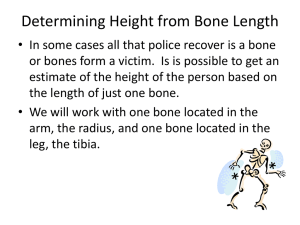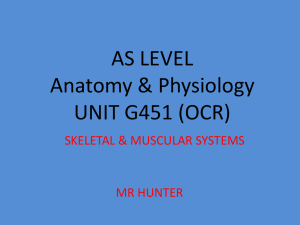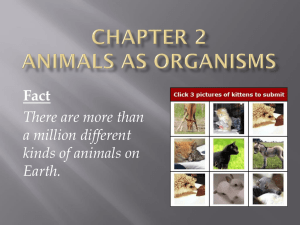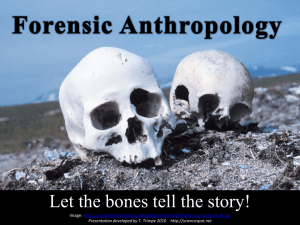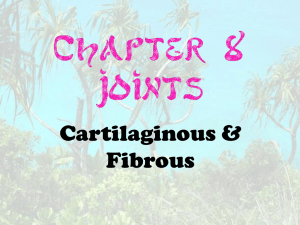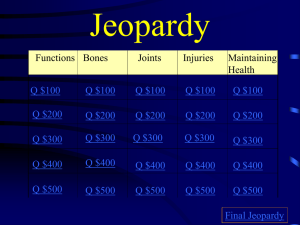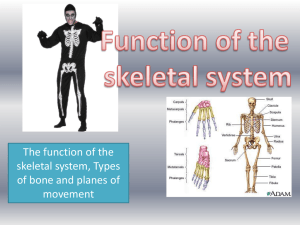THE SKELETAL SYSTEM
advertisement
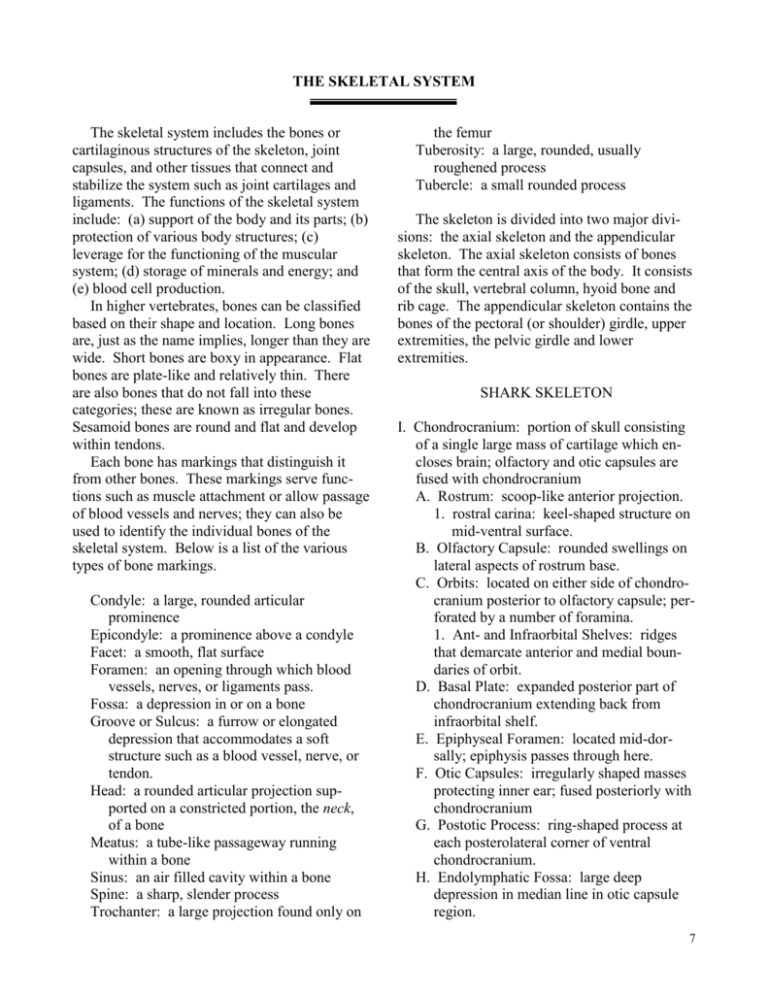
THE SKELETAL SYSTEM The skeletal system includes the bones or cartilaginous structures of the skeleton, joint capsules, and other tissues that connect and stabilize the system such as joint cartilages and ligaments. The functions of the skeletal system include: (a) support of the body and its parts; (b) protection of various body structures; (c) leverage for the functioning of the muscular system; (d) storage of minerals and energy; and (e) blood cell production. In higher vertebrates, bones can be classified based on their shape and location. Long bones are, just as the name implies, longer than they are wide. Short bones are boxy in appearance. Flat bones are plate-like and relatively thin. There are also bones that do not fall into these categories; these are known as irregular bones. Sesamoid bones are round and flat and develop within tendons. Each bone has markings that distinguish it from other bones. These markings serve functions such as muscle attachment or allow passage of blood vessels and nerves; they can also be used to identify the individual bones of the skeletal system. Below is a list of the various types of bone markings. Condyle: a large, rounded articular prominence Epicondyle: a prominence above a condyle Facet: a smooth, flat surface Foramen: an opening through which blood vessels, nerves, or ligaments pass. Fossa: a depression in or on a bone Groove or Sulcus: a furrow or elongated depression that accommodates a soft structure such as a blood vessel, nerve, or tendon. Head: a rounded articular projection supported on a constricted portion, the neck, of a bone Meatus: a tube-like passageway running within a bone Sinus: an air filled cavity within a bone Spine: a sharp, slender process Trochanter: a large projection found only on the femur Tuberosity: a large, rounded, usually roughened process Tubercle: a small rounded process The skeleton is divided into two major divisions: the axial skeleton and the appendicular skeleton. The axial skeleton consists of bones that form the central axis of the body. It consists of the skull, vertebral column, hyoid bone and rib cage. The appendicular skeleton contains the bones of the pectoral (or shoulder) girdle, upper extremities, the pelvic girdle and lower extremities. SHARK SKELETON I. Chondrocranium: portion of skull consisting of a single large mass of cartilage which encloses brain; olfactory and otic capsules are fused with chondrocranium A. Rostrum: scoop-like anterior projection. 1. rostral carina: keel-shaped structure on mid-ventral surface. B. Olfactory Capsule: rounded swellings on lateral aspects of rostrum base. C. Orbits: located on either side of chondrocranium posterior to olfactory capsule; perforated by a number of foramina. 1. Ant- and Infraorbital Shelves: ridges that demarcate anterior and medial boundaries of orbit. D. Basal Plate: expanded posterior part of chondrocranium extending back from infraorbital shelf. E. Epiphyseal Foramen: located mid-dorsally; epiphysis passes through here. F. Otic Capsules: irregularly shaped masses protecting inner ear; fused posteriorly with chondrocranium G. Postotic Process: ring-shaped process at each posterolateral corner of ventral chondrocranium. H. Endolymphatic Fossa: large deep depression in median line in otic capsule region. 7 J. Occipital Condyles: processes located ventrolaterally on either side of foramen magnum; articulate with first vertebra. II. Splanchnocranium: visceral skeleton of skull; consists of seven cartilaginous visceral arches. A. Mandibular Arch: first, most anterior and largest of visceral arches; modified into two teeth-bearing parts. 1. Palatopterygoquadrate Cartilages: fused in anterior midline to form upper jaw; bears orbital process, which projects into orbit and quadrate process, projecting from lateral end. 2. Meckel’s Cartilages: fused at midline to form lower jaw. B. Hyoid Arch: second visceral arch consisting of five cartilages; laterally articulates with chondrocranium. C. Visceral Arches Three through Seven: gill or branchial arches; has cartilaginous spine-like processes: gill rakers (anterior) and gill rays (posterior). III. Vertebral Column: two distinct types of vertebrae A. Trunk Vertebrae: each has biconcave centrum; projecting from this is a dorsal neural arch from which projects a neural spine; between adjacent spines are intercalary plates; these last three forms neural canal which houses spinal cord; spinal nerve emerge through foramina of intercalary plates; transverse processes project from ventrolateral border of centrum. B. Caudal Vertebrae: in addition to the above structures these vertebrae have hemal arches that form a hemal canal through which the caudal artery and vein pass. IV. Pectoral Girdle and Fins: anterior fins supported by U-shaped cartilage just posterior to splanchnocranium. A. Coracoid Bar: ventral part of girdle. B. Scapular Cartilage: extends dorsally from each side of coracoid bar. 1. Glenoid Surface: lateral end of scapular cartilage that articulates with fin skeleton. C. Basal Cartilages: three cartilaginous structures that articulate with glenoid surface. D. Radial Cartilages: small cartilages, arranged in rows that articulate with basals. E. Ceratotrichia: distal cartilages that support fin. CAT SKELETON I. Cranium A. Frontal Bone: paired anterior bones of cranium forming forehead and parts of orbits. B. Parietal Bone: paired bones posterior to frontal bones; constitute the greater portion of skull roof. C. Temporal Bones: paired bones inferior to parietal bones; constitutes greater portion of cranial sides. 1. Squamosal Segment: large flat region which gives rise to zygomatic process. 2. Mandibular Fossa: oval depression just inferior to base of zygomatic process; articulates with mandible. 3. External Auditory Meatus: canal-like opening just posterior to mandibular fossa; serves as a passageway for sound waves to reach “eardrum”. 4. Mastoid Process: somewhat triangular, projecting anteroventrally adjacent to tympanic bulla. 5. Tympanic Bulla: rounded bony eminence ventral to squamousal. D. Occipital Bone: single posterior bone of cranium. 1. Supraoccipital Portion: located immediately posterior to parietals; forms lambdoidal ridge. 2. Basioccipital Portion: forms posterior floor of cranium. 3. Foramen Magnum: single large opening on floor of skull which allows passage of spinal cord. 8 4. Occipital Condyles: oval processes on either side of foramen magnum; articulates with vertebral column. E. Presphenoid Bone: single bone lying in mid-line; forms roof of pharynx. F. Basisphenoind Bone: unpaired midline bone posterior to presphenoid. G. Alisphenoid Bone: wing-like bone located on ventral surface of skull. H. Ethmoid Bone: single bone in anterior part of cranial floor between orbits. 1. Mesethmoid: medial vertical plate; forms part of nasal septum. 2. Ethmoturbinals: thin scroll-like projections on either side of nasal septum; aid in warming and humidifying incoming air. II. Facial Bones A. Nasal Bones: paired long pointed bones posterior to each extenal nares. B. Premaxillary Bones: paired bones forming lower boundary of external nares. C. Maxillary Bones: paired bones forming upper jaw and hard palate. D. Malar Bones: paired bones that form prominences of cheeks with postorbital and zygomatic processes. E. Palatine Bones: paired bones posterior to maxillary bones that forms part of hard palate. F. Mandible: the lower jaw consisting of two halves; bears lower teeth. 1. Body: curved horizontal portion. 2. Ramus: perpendicular portion at posterior end of body. 3. Coronoid Process: large anterior projection of ramus. 4. Condyloid Process: posterior branch of ramus; articulates with mandibular fossa. III. Vertebral Column: composed of a number of different bones known as vertebrae; divided into five sections, each having a specific number of vertebrae: 7 cervical, 13 thoracic, 7 lumbar, 3 fused sacral, and 23 caudal; all have common characteristics but vertebrae of each section have unique characteristics. A. Common Characteristics 1. Body (or Centrum): thick disc-shaped anterior portion. 2. Vertebral Foramen: opening through which the spinal cord passes; formed by pedicles and laminae. 3. Intervertebral Foramen: opening formed by two articulating vertebrae allowing passage of single spinal nerve. 4. Transverse Processes: paired processes on either side of a vertebra. 5. Spinous Process: single process projecting posteriorly from the vertebra. IV. Thorax A. Sternum: attaches ribs through costal Cartilages; consists of eight sternebrae; divided into three parts. 1. Manubrium: first sternebra. 2. Body: composed of six ternebra. 3. Xiphoid process: last sternabra. B. Ribs: thirteen pairs of flat bones that make up thoracic wall. V. The Pectoral Girdle A. Clavicle: a long slender bone. B. Scapula: a large triangular flat bone. 1. Spine: sharp ridge on lateral surface. 2. Acromion: short blunt process projecting from ventral end of spine. 3. Glenoid Fossa: concavity on ventral apex; articulates with humeral head. VI. Arm A. Humerus: the single bone of the arm. 1. Head: rounded proximal end that articulates with glenoid fossa. 2. Capitulum: rounded knob that articulates with radius. 3. Trochlea: pulley-like surface that articulates with ulna. VII. Forearm A. Ulna: medial bone of forearm. 1. Trochlear Notch: large curved area on anterior aspect of proximal end; articulates with humeral trochlea. 2. Radial Notch: curve lateral area allowing articulation of radial head. 9 B. Radius: lateral bone of forearm. 1. Head: disc-shaped proximal end. VIII. Carpus and “Hand” A. Carpals: the seven bones of the wrist (know them as a group). B. Metacarpals: five bones between carpus and digits. C. Phalanges: bones of the digits; each digit has a proximal and distal phalanx and each finger also has a middle phalanx. IX. Pelvic Girdle A. Innominate Bone: paired bones that are formed by fusion of three separate bones during development. 1. Ilium: long anterior portion; articulates with sacrum. 2. Ischium: posterior portion. 3. Pubis: flat, curved area; left articulates with right. 4. Acetabulum: deep depression which receives head of femur to form hip joint. 5.. Obturator Foramen: large round opening formed by ischium and pubis. The two innominate bones, with sacrum of spine, form pelvis, a bowl-like structure. Superior opening is pelvic inlet; inferior opening is pelvic outlet. VI. Thigh A. Femur: single bone of thigh. 1. Head: rounded proximal end that articulates with acetabulum of pelvis. 2. Medial and Lateral Condyles: large rounded surfaces at distal end that articulate with tibia. 3. Medial and Lateral Epicondyles: rough projections on either side of distal end just proximal to respective condyles. B. Patella: sesamoid bone on anterior side of Knee. 2. Tibial Tuberosity: roughened area on ventral surface serving as a point of attachment for patellar ligament. B. Fibula: smaller, lateral bone of leg. VIII. Tarsus and Foot A. Tarsals: seven bones of ankle area of foot (know them as a group). B. Metatarsals: five bones of mid-foot. C. Phalanges: bones of toes; each toe has a proximal, middle and distal (there are only four toes). The HUMAN KNEE I. Bones A. Femur: at proximal side. B. Tibia: at mediodistal side. C. Fibula: at laterodistal side. D. Patella: within patellar ligament. II. Ligaments A. Quadriceps Ligament: insertion of quadriceps femoris muscle of thigh; ends at patella. B. Patellar Ligament: continuation of quadriceps ligament; begins at patella; attaches to tibial tuberosity. C. Tibial and Fibular Collateral Ligaments: proximal ends attached to respective femoral epicondyles; distal end attached to respective bones. D. Anterior and Posterior Cruciate Ligaments: proximal end of both attached to posterior femur in intercondyler space; posterior cruciate at attached distally on posterior tibia; anterior cruciate attached distally anteriorly between tibial condyles. III. Articular Pads: made of fibrocartilage A. Medial Meniscus: C-shaped ring. B. Lateral Meniscus: complete ring. VII. Leg A. Tibia: larger, medial bone of leg. 1. Medial and Lateral Condyles: expanded area at proximal end which articulates with respective condyles of femur to form knee joint. 10

